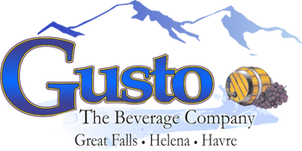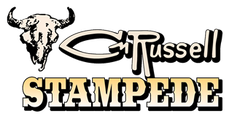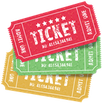CMR Stampede PRCA Rodeo
Sunday ✪ July 21, 2024
Stanford, Montana
1:30p.m. @ the Fairgrounds
Rodeo Tickets
General Admission: $12.00 per person
Ages 12 & Under: $8.00 per person
Sunday ✪ July 21, 2024
Stanford, Montana
1:30p.m. @ the Fairgrounds
Rodeo Tickets
General Admission: $12.00 per person
Ages 12 & Under: $8.00 per person
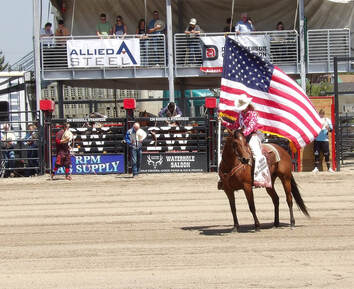
It Started in 1964. On Montana’s 75th anniversary to Statehood, the Stanford Commercial Club decided it was time to hold a rodeo in the heart of Charlie Russell Country. The rodeo would serve two purposes: 1) Provide a quality entertainment event for folks in the area 2) Raise funds for worthwhile causes in Central Montana.
Not having the manpower to organize such an event; the Commercial Club turned to the local Jaycees organization, which gladly took on the task. Volunteers came out of the woodwork – farmers, ranchers, mechanics, contractors, local businessmen, - even a barber and a young veterinarian were included in the workforce.
Starting from scratch, the group constructed a well-built arena; and sturdy bleachers for the fans to sit on. A group of ten ranchers donated $100 each for the original expenses. The first rodeo was no doubt a little rough around the edges. The stock was provided by Bloxham & Nordtome Co.; while the local veterinarian (Dr. John Gee) won the bull riding. Over the years, the CM Russell Stampede has developed into a finely-tuned work of art.
The Jaycees transitioned into the CM Russell Stampede Club. The event has expanded into two days of family entertainment; including the rodeo, a Quick Draw, western barbecue, free music, and many other events.
Many members and volunteers have come and gone since the original CM Russell Stampede was held, 55 years ago. However, the philosophy has remained the same – hold events that provide quality family entertainment; and raise funds for many worthwhile causes in central Montana.
Not having the manpower to organize such an event; the Commercial Club turned to the local Jaycees organization, which gladly took on the task. Volunteers came out of the woodwork – farmers, ranchers, mechanics, contractors, local businessmen, - even a barber and a young veterinarian were included in the workforce.
Starting from scratch, the group constructed a well-built arena; and sturdy bleachers for the fans to sit on. A group of ten ranchers donated $100 each for the original expenses. The first rodeo was no doubt a little rough around the edges. The stock was provided by Bloxham & Nordtome Co.; while the local veterinarian (Dr. John Gee) won the bull riding. Over the years, the CM Russell Stampede has developed into a finely-tuned work of art.
The Jaycees transitioned into the CM Russell Stampede Club. The event has expanded into two days of family entertainment; including the rodeo, a Quick Draw, western barbecue, free music, and many other events.
Many members and volunteers have come and gone since the original CM Russell Stampede was held, 55 years ago. However, the philosophy has remained the same – hold events that provide quality family entertainment; and raise funds for many worthwhile causes in central Montana.
Bareback Riding
Sponsored by Zoeta (Stephanie Hedrick)
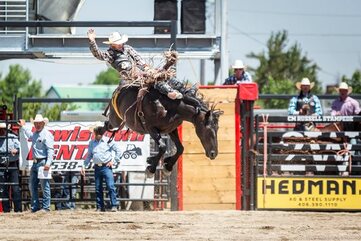 Photo credit: Matthew Strissel
Photo credit: Matthew Strissel
Bareback riding, developed in the rodeo arena many years ago, consistently produces some of the wildest action in the sport. A bareback rider begins his ride with feet placed above the break of the horse's shoulder. If the cowboy's feet are not in the correct position when the horse hits the ground on its first jump out of the chute, the cowboy has failed to "mark out" the horse properly and is disqualified. Throughout the eight-second ride, the cowboy must grasp the rigging (a handhold made of leather & rawhide) with only one hand. Optimum spurring action begins with the rider in control, his heels at the horse's neck. He then pulls his feet, toes turned outward, to the horse's withers until the cowboy's feet are nearly touching the bareback rigging. A rider is disqualified if he touches his equipment, himself or the animal with his free hand. The rider is judged on his control during the ride and on his spurring technique. The score is also based on the rider's "exposure" to the strength of the horse. In addition, the horse's performance accounts for half the potential score.
Ladies Barrel Racing
Sponsored by Seth Wildung + Roger L. Daniel's Insurance
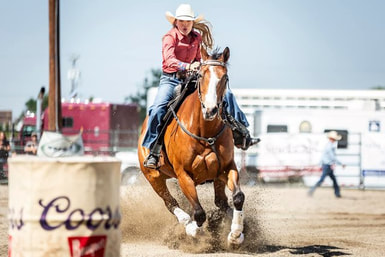 Photo credit: Matthew Strissel
Photo credit: Matthew Strissel
Although barrel racing may look less harrowing than some other rodeo events, it certainly is not for the faint-hearted. The horsemanship skills and competitive drive in this fast and furious event make it a crowd favorite. In barrel racing, the contestant enters the arena at full speed on a sprinting American Quarter Horse. As they start the pattern, the horse and rider trigger an electronic eye that starts the clock. Then the racer rides a cloverleaf pattern around three barrels positioned in the arena, and sprints back out of the arena, tripping the eye and stopping the clock as she leaves. The contestant can touch or even move the barrels, but receives a five-second penalty for each barrel that is overturned. With the margin of victory measured in hundredth of seconds, knocking over one barrel spells disaster for a barrel racing competitor.
Bull Riding
Sponsored by Reilly Insurance Agency, Aeric Reilly
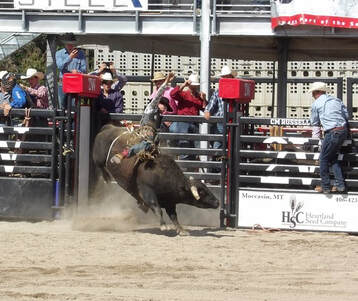 Photo Credit: Kim Holzer
Photo Credit: Kim Holzer
Unlike the other rough stock contestants, bull riders are not required to spur. No wonder. It's usually impressive enough just to remain seated for eight seconds on an animal that may weigh more then a ton and is as quick as he is big. Upper body control and strong legs are essential to riding bulls. The rider tries to remain forward, or "over his hand," at all times. Leaning back could cause him to be whipped forward when the bull bucks. Judges watch for good body position and other factors, including use of the free arm and spurring action. Although not required, spurring will add points to a rider's score. As in all the riding events, half of the score in the bull riding is determined by the contestant's performance and the other half is based on the animal's efforts. A bull rider will be disqualified for touching the animal, himself or his equipment with his free hand.
Saddle Bronc Riding
Sponsored by Steel Etc.
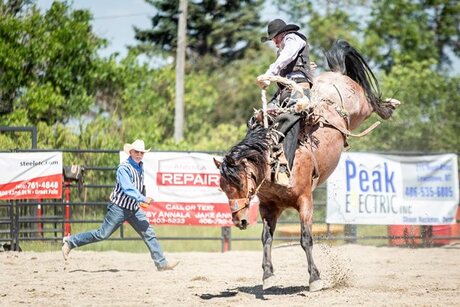 Photo credit: Matthew Strissel
Photo credit: Matthew Strissel
Rodeo's classic event, saddle bronc riding, has roots that run deep in the history of the Old West. Ranch hands would often gather and compete among themselves to see who could display the best style while riding unbroke horses. It was from this early competition that today's event was born. Each rider must begin his ride with his feet over the bronc's shoulders to give the horse the advantage. A rider who synchronizes his spurring action with the animals bucking efforts will receive a high score. Other factors considered in the scoring are the cowboy's control throughout the ride, the length of his spurring stroke and how hard the horse bucks. Model spurring action begins with the rider's feet far forward on the bronc's point of shoulder, sweeping to the back of the saddle, or "cantle," as the horse bucks. The rider then snaps his feet back to the horse's neck a split second before the animal's front feet hit the ground. Disqualification results if, prior to the buzzer which sounds after eight seconds, the rider touches the animal, himself or his equipment with his free hand, if either foot slips out of a stirrup, if he drops the bronc rein, or if he fails to have his feet in the proper "mark out" position at the beginning of the ride.
Steer Wrestling
Sponsored by Green Giant Feedlot
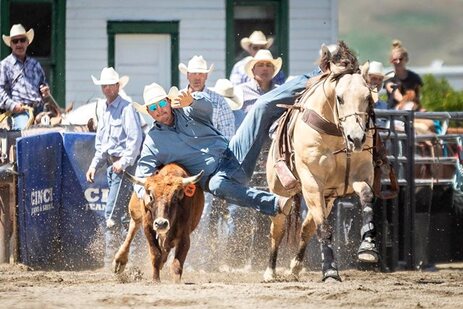 Photo credit: Matthew Strissel
Photo credit: Matthew Strissel
Wrestling a steer requires more than brute strength. The successful steer wrestler, or bulldogger, is strong, to be sure, but he also understands the principles of leverage. The steer wrestler on horseback starts behind the barrier, and begins his chase after the steer has been given a head start. If the bulldogger leaves too soon and breaks the barrier, he receives a ten-second penalty. The steer wrestler is assisted by a hazer, another cowboy on horseback tasked with keeping the steer running in a straight line. When the bulldogger's horse pulls even with the steer, he eases down the right side of the horse and reaches for the steer's horns. After grasping the horns, he digs his heels into the dirt. As the steer slows, the cowboy turns the animal, lifts up on its right horn and pushes down with his left hand in an effort to tip the steer over. After the catch, the steer wrestler must either bring the steer to a stop or change the direction of the animal's body before the throw or he is disqualified. The clock stops when the steer is on his side with all four legs pointing the same direction.
Team Roping
Sponsored by Joyce Fuel & Feeds
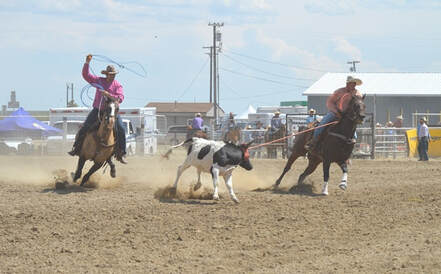
In rodeo's only true team event, two ropers, a "header" and a "heeler," work together to catch a steer. The header is the first cowboy out of the box. He may rope the steer around the head and one horn, around the neck or around both horns, which are specially wrapped for the event. As with all timed events, if the header fails to give the animal its allotted head start, a 10-second penalty is added to the total time. After making his catch, the header rides to the left, taking the steer in tow. The heeler moves in and ropes both hind legs. Catching only one hind leg results in a five-second penalty. If the heeler tosses his loop before the header has changed the direction of the steer and has the animal moving forward, it's called a "crossfire" and it results in disqualification. The clock is stopped when the slack has been taken out of both ropes and the contestants are facing each other.
Tie Down Roping
Sponsored by Stockman Insurance
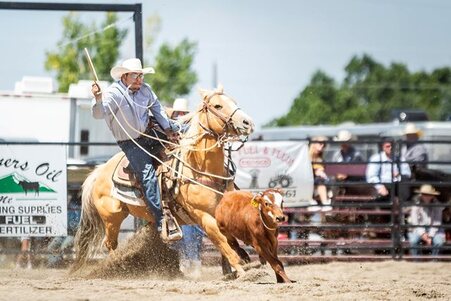 Photo credit: Matthew Strissel
Photo credit: Matthew Strissel
Like bronc riding, calf roping is an event born on the ranches of the Old West. Sick calves were roped and tied down for medical treatment. Today, success in calf roping depends largely on the teamwork between the cowboy and his horse. The luck of the draw is also a factor. A feisty calf that runs fast or kicks hard can foil a roper's finest effort. After the calf is given a head start, horse and rider give chase. The contestant ropes the calf, then dismounts and runs to the animal. After catching and flanking the calf, the cowboy ties any three of the animal's legs together using a "pigging string" he carries in his teeth until needed. If the calf is not standing when the contestant reaches it, the cowboy must allow the animal to stand, then flank it. When the cowboy completes his tie, he throws his hands in the air as a signal to the judge. He then remounts his horse and allows the rope to become slack. The run is declared invalid if the calf kicks free within six seconds. As with any times event, a 10-second penalty is added if the calf roper breaks the barrier at the beginning of the run.
Ladies Breakaway Roping
Sponsored by Travis + Sherry Berg / Rimrock Arena
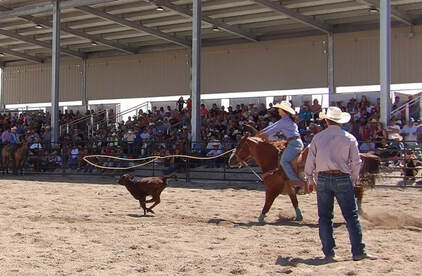
Women's breakaway roping is comparable to men's tie-down roping, except the cowgirls are not required to dismount and tie the calf.
In breakaway roping, the cowgirl has a flag tied close to the end of her rope and a nylon string tied from the rope to the saddle horn.
In breakaway roping, the cowgirl has a flag tied close to the end of her rope and a nylon string tied from the rope to the saddle horn.
Stock for the 2024 CMR Stampede is provided by J Bar J Rodeo.
In 2008, Sparky and Marlene Dreesen formed J Bar J, Inc. With the combination of the Gold Buckle stock and that of J Bar J, they are producing top quality rodeos from east to west.
J Bar J has been taking stock to the NFR since 2005. They currently have 12 PRCA sanctioned rodeos and 3 PRCA sanctioned Bronc Ridings for 2021. Stock travels as far east as Tennessee and to western Montana and south to Texas for the winter rodeos.
J Bar J has been recognized in 2010 and 2014 with the PRCA Remuda Award. This annual award goes to the stock contractor who provides the best most consistent pen of bucking horses in the PRCA. One of their best known horses is “Bugs Bunny.”
J Bar J has been taking stock to the NFR since 2005. They currently have 12 PRCA sanctioned rodeos and 3 PRCA sanctioned Bronc Ridings for 2021. Stock travels as far east as Tennessee and to western Montana and south to Texas for the winter rodeos.
J Bar J has been recognized in 2010 and 2014 with the PRCA Remuda Award. This annual award goes to the stock contractor who provides the best most consistent pen of bucking horses in the PRCA. One of their best known horses is “Bugs Bunny.”



